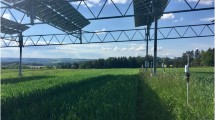Summary
The rates of water use and leaf surface conductance of Citrullus colocynthis (Cucurbitacea) were evaluated from measurements of the surface temperature and microenvironment of leaves. At desert sites in Saudi Arabia the transpiration rates reached 0.13–0.17 g m-2 s-1 and the leaf temperatures were always close to air temperature. Leaf models (dry) placed in the canopy were considerably warmer than the air. To investigate responses over a wider range of conditions, plants were grown in a controlled environment room. It was found that when conditions were made hotter than those that occurred in the desert, the stomatal conductance increased greatly. Transpiration rate attained 0.6 g m-2 s-1 and the leaves were up to seven degrees cooler than the air. The results suggest a finely-tuned control mechanism working like a switch when the leaves experience extreme conditions, and enabling the plant to avoid lethal temperatures.
Similar content being viewed by others
References
Althawadi AM (1985) The leaf energy balance of a desert plant Citrullus colocynthis (L.) Schrad, with special reference to water economy. Ph D Thesis, University of Edinburgh
Anon (1977) Agro Climatological Study of the Arab World (in Arabic). Government Printers, Riyadh.
Evanari M, Shanan L, Tadmor N (1971) The Negev, the Challenge of a Desert. Harvard University Press
Gates DM, Papian LE (1971) Atlas of Energy Budget of Plant Leaves. Academic Press, New York
Grace J (1974) The effect of wind on grasses 1. Cuticular and substomatal transpiration. J Exp Bot 25:542–551
Grace J (1983) Plant-Atmosphere Relationships. Chapman and Hall, London
Lange OL (1959) Untersuchungen über Wärmehaushalt und Hitzeresistenz mauretanischer Wüsten-und Savannenpflanzen. Flora 147:595–651
Lange OL (1962) Über die Beziehungen zwischen Wasser- und Wärmehaushalt von Wüstenpflanzen. Veröffentlichungen des Geobotanischen Institutes der Eidg. Techn. Hochschule, Zürich 37:155–168
Lange OL, Lange R (1963) Untersuchungen über Blattemperaturen, Transpiration und Hitzeresistenz an Pflanzen mediterraner Standorte (Costa brava, Spanien) Flora 153:387–425
Linacre ET (1964) A note on a feature of leaf and air temperatures. Agric Met 1:66–72
Linacre ET (1967) Further notes on a feature of leaf and air temperatures. Archiv für Meteorologie, Geophysik und Bioklimatologie 15:422–436
McCree KJ (1981) Photosynthetically active radiation. In: Physiological plant ecology 1. Response to the physical environment, Lange OL, Nobel PS, Osmond C, Ziegler H (eds) Vol 12A. Springer, Berlin Heidelberg New York, pp 41–55
Maximov NA (1929) The plant in Relation to Water. Allen and Unwin, London
Monteith JL (1973) Principles of Environmental Physics. Arnold, London
Pearcy RW, Berry JA, Bartholemew B (1974) Field photosynthetic performance and leaf temperatures of Phragmites communis under summer conditions in Death Valley, California. Photosynthetica 8:104–108
Schulze E-D, Lange OL, Koch W (1972) Ökophysiologische Untersuchungen an Wild- und Kulturpflanzen der Negev-Wüste II. Die Wirkung der Außenfaktoren auf CO2-Gaswechsel und Transpiration am Ende der Trockenzeit. Oecologia (Berlin) 8:334–355
Schulze E-D, Lange OL, Kappen L, Buschbom U (1973) Stomatal responses to changes in temperature at increasing water stress. Planta 110:29–42
Sen DN (1973) Ecology of indian desert III. Survival adaptations of vegetation in dry environments. Vegetatio 27:201–65
Sen DN, Bhandari MC (1974) On the ecology of a perennial cucurbit in the Indian arid zone-Citrullus colocynthis (Linn) Schrad Int J Biometeor 18:113–120
Smith WK (1978) Temperatures of desert plants: another perspective on the adaptability of leaf size. Science 201:614–616
Squire GR, Mansfield TA (1972) Studies of the mechanism of action of fusicoccin, the fungal toxin that induces wilting, and its interaction with abscisic acid. Plant 105:71–78
Stălfelt MG (1962) The effect of temperature on opening of the stomatal cells. Physiologia Plantarum 15:772–779
Stocker O (1976) The water-photosynthesis syndrome and the geographical plant distribution in the Saharan deserts. In: Water and Plant Life: Problems and Modern Approaches. Lange OL, Kappen L, Schulze E-D (eds) Springer, Berlin Heidelberg New York, pp 506–521
Unsworth MH, Black VJ (1981) Stomatal responses to pollutants. Zohary M (1962) Plant life of Palestine: Israel and Jordan. Ronald Press, New York
Author information
Authors and Affiliations
Rights and permissions
About this article
Cite this article
Althawadi, A.M., Grace, J. Water use by the desert cucurbit Citrullus colocynthis (L.) Schrad.. Oecologia 70, 475–480 (1986). https://doi.org/10.1007/BF00379514
Received:
Issue Date:
DOI: https://doi.org/10.1007/BF00379514




